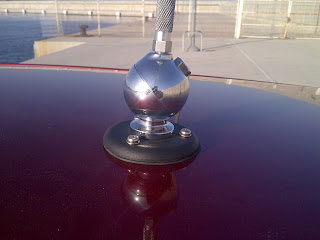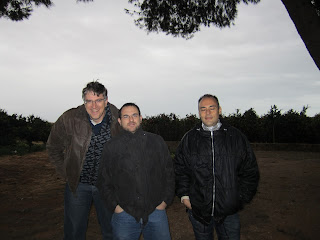However, those antennas have some issues, namely:
- The centre fed design gets to be pretty big for lower bands, requiring bigger supports and/or guying.
- The coax feed did not give me much confidence, difficult to keep it coming off at a right angle, and "hot" mic was a sure sign of common mode currents on the outside of the coax cable.
Since those experiments last autumn (2012), I have been thinking about different options, that might keep the good points of the centre fed designs, and overcome their issues. When considering antennas, I consider them for two different kinds of use. One is for "working a new one". For this kind of use, I put more weight on a quick setup, high gain antenna, and less weight on rotatability.
Parallel to that though, I was also wondering how much of a difference there was between setting up a 3 element yagi and two x two element phased yagis. I asked Elías if he could do the simulation for this one for me and this is what he came up with:
His conclusion is that the 3 element yagi is probably a better choice, giving a broader pattern, easier installation, and only a fraction less gain on the main lobes.
END FED DESIGNS
I have used commercialy made end-fed antennas with some success, both at my mountain house in EA1 (on 20m) and also portable (on 10m). After the difficulty installing the centre fed two element phased beam, I looked at the possibilty of using end-feds for this.
I mentioned this on the air one day to my friend Jim ZL1BOS, who suggested I contact KH6MB Martin, a gentlemen he'd met on his travels in Hawaii and who used end fed beams by the water there. As luck would have it, that very same day Martin answered one of my CQ calls and we talked briefly about the matter. I zipped off an email and got some info back from Daryl W7TAE but never did get all the information I needed. However there is a nice pic of Martin's variable matchbox kit at http://ham.aditl.com/ham-radio/techie-stuff/efhw-tuner/ and some nice photos of their setups on the KH6TE QRZ.com page
The nature of end fed antennas, with high impedance feedpoints, worried me with possible problems with common mode currents, so I had a look to see what W8JI had to say on the matter. And basically he says that while these antennas can be made to work, there are significant possible problems. Since these antennas are often used QRP or low power though, the symptoms at this power level are often not appreciable and therefore go unnoticed. You can read the full story here.
So, although I haven't completely discarded the endfeds, especially thinking of low power and perhaps phased antennas on the higher bands, the end fed is not without its problems.
ROTARY YAGIS
When considering possibilities for a fixed antenna on a tower, in the case that one day I might be granted permission to do this at the port, I thought about rotary vertical yagis, using the same design criteria I used for my fixed centre fed yagis, but set up like a traditional yagi, the only difference being that the elements are vertical instead of horizontal.
The 2 element design was quite easy to make, using the MFJ 2299 as the basis for this. It could be set up quite easily on a mount like the one I used for the 2 element quad for 15m:

The two-dimensional design of the yagi would make it much easier to install, I could use a rotator, it wouldn't be too hard to change bands, and it would be easy to tune each element with the analyser and then short out the reflector just by screwing in a shorted PL connector.
One of the disadvantages of this system is that it can only be either 2 or 4 elements, since a 3 element design would put the bottom part of the centre element right next to the metal mast. 2 elements is maybe not enough gain, 4 elements is starting to stretch the mechanics of the thing. I couldn't think of a suitable non-conductive support, so I asked on eham just how much the metal mast was change the pattern in any case of a 2 element design. A kind person modelled this for me and you can see the difference here . It shows a significant distortion of the pattern which whilst not making the antenna unuseable, does mean I should probably keep thinking about other options.
TRAILER TOWER / TRAILER YAGI
If you're wondering why I'm not considering using the quad in the photo, it's because the setup is really difficult. However I did look at the option of using a trailer tower for this. I guess there are more manufacturers, but the ones I was looking at were made by Tennamast , a good scottish company :)
Whilst looking at the trailers, and seeing if there was a local manufacturer who might do something similar, it struck me that I might be able to use a trailer as a basis for a three or even four element vertical yagi. But instead of being a vertical dipole design, it would use the "vertical with two elevated radials" design. This way, I could overcome the metal mast problem. And being on a trailer with wheels, to rotate the antenna was a simple matter of turning the trailer round.
I really like this idea. It makes for a really quick setup, since much of the hardware can be left assembled on the trailer and its a case of installing some pre-assembled elements and away you go (a very important aspect for me).
What has made me decide not to go for either of the trailer options in the end is a practical problem of where to store it! In my underground car park at the home QTH there is no space. And whilst I could keep it at my QTH in La Eliana during the Winter, I'd need to move it for the summer for when guests come to the house.
MY CURRENT "BEST IDEA"
As a "variation on a theme", I reckon I can probably make the "vertical yagi with elevated ground planes" work on my car, placed on a roof rack or ladder rack. At first sight it sounds like something that our 11m cb brothers use, but from what I can tell, their installations don't seem to be very well optimised and looks like they get more benefit out of their 10kW amps than the antennas! Installation would not be as quick as on a trailer, but I reckon with a bit of careful thought and planning, I will be able to make this work.
I already tried a basic version of this (see http://www.ea5on.com/2012/11/more-on-2-element-vertical-beams.html) but neither element used tuned radials, nor was the spacing optimum, which would lead me to hope that a properly installed one should work better.
At this moment in time I am sourcing parts if I don't come up against a "DUH I hadn't thought of that" moment, this will sooner or later become a reality.....watch this space, but don't hold your breath!







































